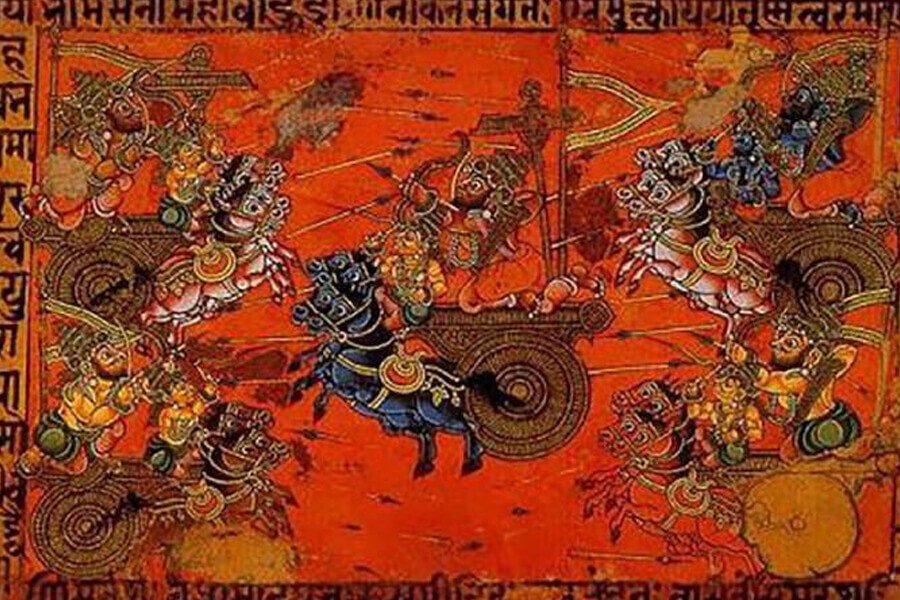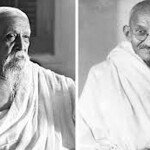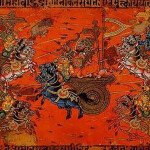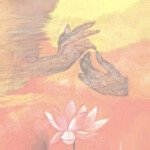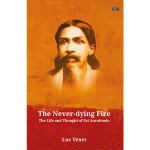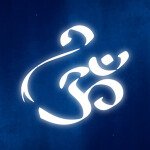Mr Basham, author of the “The Wonder that was India”, feels that “much of Sanskrit literature is dry and monotonous, or can only be appreciated after a considerable effort of the imagination” (Wonder that Was India, page 401), which shows a total misunderstanding of the greatness of the genius of that Mother of all languages. Sri Aurobindo evidently disagrees with him: “The ancient and classical literature of the Sanskrit tongue shows both in quality and in body an abundance of excellence, in their potent originality and force and beauty, in their substance and art and structure, in grandeur and justice and charm of speech, and in the heightened width of the reach of their spirit which stands very evidently in the front rank among the world’s great literatures.” (Foundations of Indian Culture p. 255)
Four masterpieces seem to embody India’s genius in literature: the Vedas, the Upanishads, the Ramayana, the Mahabharata. As seen earlier, the Vedas represent “a creation of an early and intuitive and symbolic mentality” (Foundations of Indian Culture, p.260). It was only because the Vedic rishis were careful to clothe their spiritual experiences in symbols, so that only the initiated would grasp them, that their meaning has escaped us, particularly after they got translated in the last two centuries. “The Veda is the WORD discovering truth and clothing in image and symbol, the mystic significance of life”, wrote again Sri Aurobindo. (India’s Rebirth, p.95)
As to the Upanishads, asserts the Sage from Pondichery, “they are the supreme work of the Indian mind, that of the highest self-expression of genius, its sublimest poetry, its greatest creation of the thought and word.. a large flood of spiritual revelation…” (Foundations of Indian Culture p.269). The Upanishads are Philosophy, Religion and Poetry blended together. They record high spiritual experiences, are a treaty of intuitive philosophy and show an extraordinary poetic rhythm. It is also a book of ecstasy: an ecstasy of luminous knowledge, of fulfilled experience, “a book to express the wonder and beauty of the rarest spiritual self-vision and the profoundest illumined truth of Self and God and the Universe”, writes Sri Aurobindo (Foundations of Indian Culture, 269). The problem is that the translations do not render the beauty of the original text, because these masterpieces have been misunderstood by foreign translators, who only strive to bring out the intellectual meaning without grasping the soul contents of it and do not perceive the ecstasy of the seer “seeing” his experiences.
But without doubt, it is the Mahabarata and the Ramayana, which are dearest to all Indians, even today. Both the Mahabarata and the Ramayana are epical, in the spirit as well as the purpose. The Mahabarata is on a vast scale, maybe unsurpassed even today, the epic of the soul and tells a story of the ethics of India of that time, its social, political and cultural life. It is, notes Sri Aurobindo, “the expression of the mind of a nation, it is the poem of itself written by a whole nation… A vast temple unfolding slowly its immense and complex idea from chamber to chamber” (Foundations of Indian Culture, p 287). More than that even, it is the HISTORY OF DHARMA, of deva against asura, the strife between divine and titanic forces. You find on one side, a civilisation founded on Dharma, and on the other, beings who are embodiments of asuric egoism and misuse of Dharma. It is cast in the mould of tales, legends, anecdotes, telling stories of philosophical, religious, social, spiritual values: “as in Indian architecture, there is the same power to embrace great spaces in a total view and the same tendency to fill them with an abundance of minute, effective, vivid and significant detail”. (Foundations of Indian Culture, p 288).
The Baghavad Gita must be the supreme work of spiritual revelation in the whole history of our human planet, for it is the most comprehensive, the most revealing, the highest in its intuitive reach. No religious book ever succeeded to say nearly everything that needs to be known on the mysteries of human life: why death, why life, why suffering? why fighting, why duty? Dharma, the supreme law, the duty to one’s soul, the adherence to truth, the faithfulness to the one and only divine reality which pertains to all things in matter and spirit. “Such then is the divine Teacher of the Gita, the eternal Avatar, the Divine who has descended into human consciousness, the Lord seated within the heart of all beings, He who guides from behind the veil all our thought and action”. (Sri Aurobindo; Essays on the Gita, page 17)
The Ramayana’s inner genius does not differ from the Mahabharata’s, except by a greater simplicity of plan, a finer glow of poetry maybe. It seems to have been written by a single hand, as there is no deviation from story to story. But it is, remarks Sri Aurobindo, “like a vastness of vision, an even more winged-flight of epic in the conception and sustained richness of minute execution in the detail (289). For Indians, the Ramayana embodies the highest and most cherished ideals of manhood, beauty, courage, purity, gentleness. The subject is the same as in the Mahabharata: the struggle between the forces of light and darkness; but the setting is more imaginative, supernatural and there is an intensification of the characters in both their goodness and evil. As in the Mahabharata too, we are shown the ideal man with his virtues of courage, selflessness, virtue and spiritualized mind. The asuric forces have a near cosmic dimension of super-human egoism and near divine violence, as the chased angels of the Bible possessed after them. “The poet makes us conscious of the immense forces that are behind our life and sets his action in a magnificent epic scenery, the great imperial city, the mountains and the ocean, the forest and wilderness, described with such largesse as to make us feel that the whole world were the scene of his poem and its subject the whole divine and titanic possibility of man, imagined in a few great or monstrous figures”. (Foundations of Indian Culture page 290)
Does India’s literary genius end with the Ramayana? Not at all. It would take too long here to jot down all the great figures of Indian literature and this is not a literary treatise. But we may mention Kalidasa, whose poetry was imitated by all succeeding generations of poets, who tried to copy the perfect and harmoniously designed model of his poetry. The Puranas and the Tantras, “which contain in themselves”, writes Sri Aurobindo, “the highest spiritual and philosophical truths, while embodying them in forms that are able to carry something of them to the popular imagination and feeling by way of legend, tale, symbols, miracles and parables.” (Foundations of Indian Culture P.312).
The Vaishnava poetry, which sings the cry of the soul for God, as incarnated by the love stories of Radha and Krishna, which have struck forever Indian popular imagination, because they symbolize the nature in man seeking for the Divine soul through love. Valmiki, also moulded the Indian mind with his depiction of Rama and Sita, another classic of India’s love couples and one that has survived through the myth of enduring worship, in the folklore of this country, along with the popular figures of Hanuman and Laksman. “His diction”, remarks Sri Aurobindo, “is shaped in the manner of the direct intuitive mind as earlier expressed in the Upanishads”.
But Indian literature is not limited to Sanskrit or Pali. In Tamil, Tiruvalluvar, wrote the highest ever gnomic poetry, perfect in its geometry, plan and force of execution. In Hindi, Tulsidas, is a master of lyric intensity and the sublimity of epic imagination. In Marathi, Ramdas, poet, thinker, yogi, deals with the birth and awakening of a whole nation, with all the charm and the strength of a true bhakti. In Bengal, there is Kashiram, who retold in simple manner the Mahabharata and the Ramayana, accompanied by Tulsidas who did the same thing in Hindi and who managed to combine lyrical intensity, romantic flight of imagination, while retaining the original sublimity of the story. One cannot end this short retrospective without mentioning Chaitanya, Nanak, Kabir, Mirabai…All these remarkable writers have often baffled the Western mind, which could never understand the greatness of Indian literature, forgetting that in India everything was centred around the spiritual.
Printed with permission of the author (April 2020)


